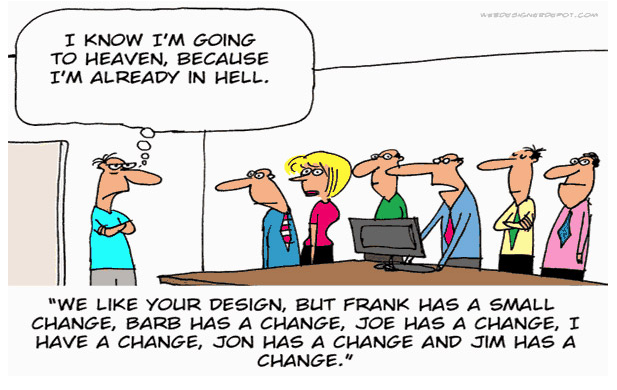On our social media, we often joke about how many changes we as developers & designers receive from clients with the hashtag #webdesignerproblems.

Funny as it may be, in real life, it can be frustrating to have to re-do images or implement the client’s changes because he’s either unsure of what he wants or is over ambitious or simply, hard to please.
In this article, we’ll discuss how to turn down such requests politely (this applies to any type of customer request).
Genuinely listen to your customer’s request
First off, hear your customer out. Hearing him out lets your customer know he’s valued and important. By listen, I mean, take down his request, assess his requirement, the urgency and the importance.
Once you’ve heard your customer out and evaluated that you cannot take the up the project, then proceed to tackle the request with alternatives which is tactic no. 2.
Try an alternative
Instead of saying an outright “no” which could seem rude, find a way to turn down a request in a positive manner. You can do this by asking the customer or client a few questions like:
- Why do you want to do this?
- What resolution are you expecting?
Asking questions like these convey to your customer that you’re trying your best to work things out. Surprisingly, sometimes the client may think he needs one thing but could actually need something else. In the meantime, look for alternative solutions instead of his exact outcome. Ask yourself what work around you can find.
Explain what you can do
In other words, be honest. Now, yes you don’t have to oblige every request you get (that’s the point of this article) but again, instead of a “no”, explain to your client why you can’t take up his request.
Explaining it to him lets him understand you’ve considered his request but unfortunately, can’t provide the exact outcome that he’s expecting due to time or bandwidth constraints. Explaining helps maintain the rapport you have with the customer while still being realistic about your work.
Make sure your rejection email is clear
Sometimes it’s hard to convey a good-intentioned message on email as email doesn’t carry tone (Fun fact, Fox Type is a web app that actually analyzes how polite or rude your message is).
While rejecting customer requests on email, make sure:
- You thank the customer for his request
- Make sure you’re clear about declining the request
- Mention what you can do
- Reaffirm your answer at the end
Let me give you a real-life example. We accept good quality guest posts on the ResellerClub blog and a lot of requests that do come to me are from experienced writers with above average content. Now, sometimes a writer (who has already published a guest article on our blog) requests to publish more than 1 article. In this case, I politely email them something that goes like this:
Hey xyz,
Thank you for writing in to me. Your first article has been performing well on our blog. Many congratulations!
Thank you for your interest to publish a second piece of content on our blog. Unfortunately, since we just posted an article in your name, it will be a while till we publish one again because we want to give other writers a chance too.
We do value your partnership and will reach out to you if we do decide to publish content in your name again. Have a great day!
Cheers.
Acknowledge your existing relationship, build rapport
Let him know you’ve heard his request before you say no. Proceed to explain your reason for declining his request.
Assure him you’ll revisit his request in the future
Conclusion
I hope I’ve managed to give you some direction with rejecting requests politely. Pro tip: Pick and choose which ones to reject. It’s OK to reject customer requests in these scenarios:
- Too many / unreasonable changes from the client
- Lack of bandwidth/ resources to take up a new client
- Beyond discussed scope of work (In this case, I suggest pitching this as an ‘upgrade’ at an additional fee)
- Breach of a policy, non-compete
Addressing the ‘unlimited’
Many brands and companies offer ‘unlimited’ services which almost always will have soft limits and is still subject to an Acceptable Use Policy (AUP). If you’re going to be providing an ‘unlimited’ service, ensure you communicate this to your customers so tackle multiple or unreasonable requests.
Let us know in the comments section if you’ve got more tips.
There is no ads to display, Please add some



